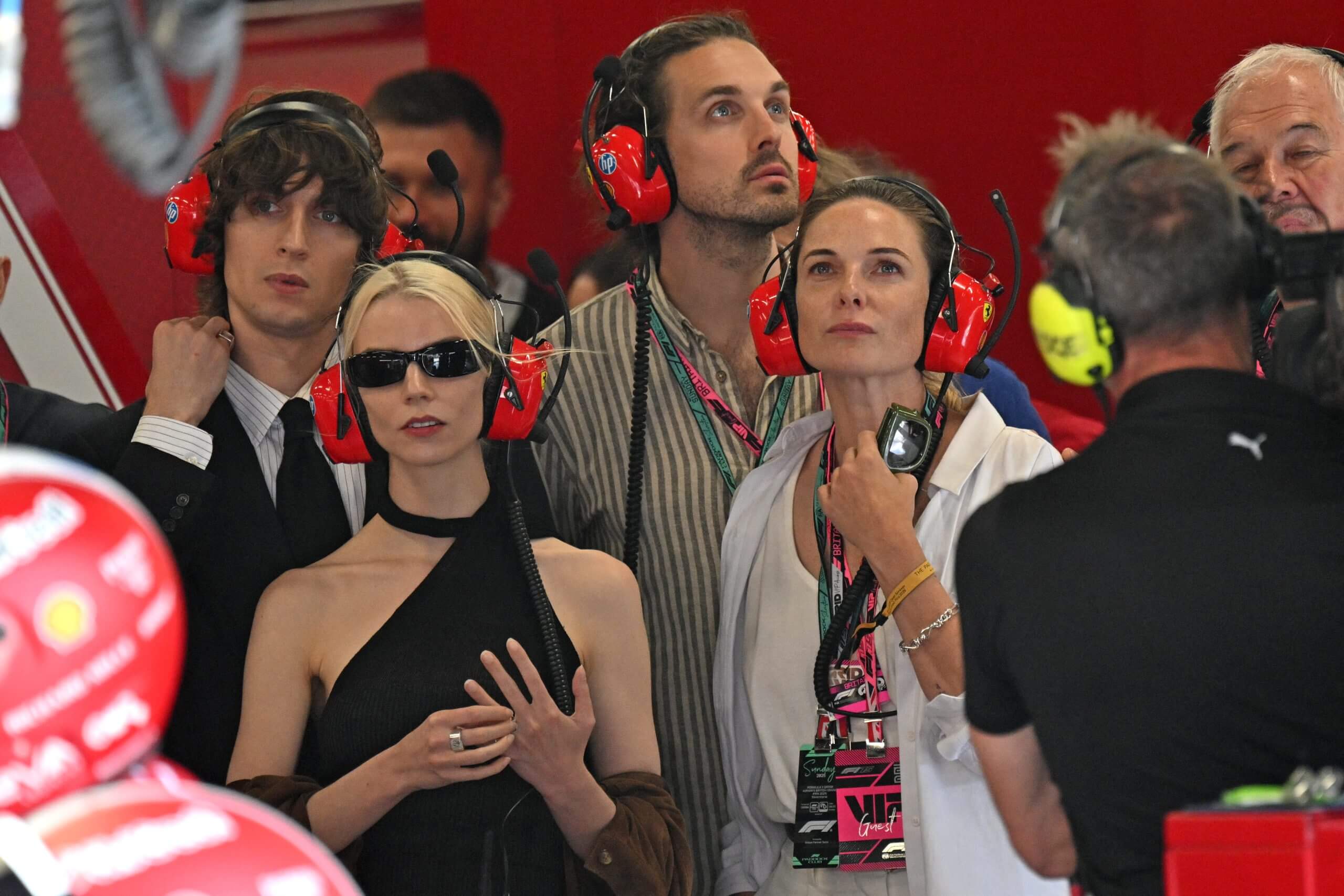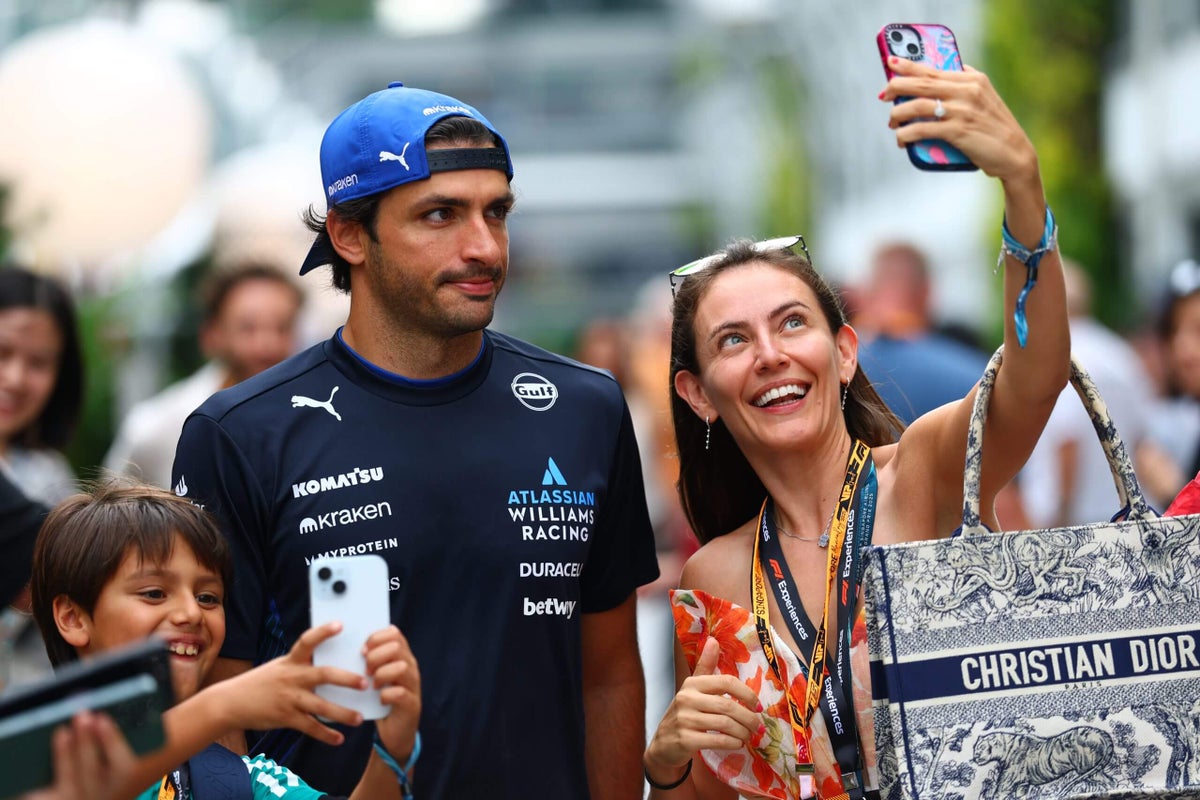Carlos Sainz had a busy night in Singapore.
He started 18th after being disqualified from qualifying for technical breaches on his Williams car. He fought through the field at Marina Bay Street Circuit on Sunday, where overtaking is notoriously tricky, and claimed a point in 10th place.
I’ll be a little clearer: He stormed to 10th by Lap 30 of 62. And in the final 10 laps, having fallen back to 13th, climbed back to 10th and claimed a point. Exceptional driving.
When it was over, Sainz had some thoughts about what viewers at home had seen — or hadn’t seen. He criticized the sport’s broadcast coverage for missing key race action and focusing on “famous people and girlfriends.”
“Yes, it’s becoming a bit of a trend,” Sainz told Spanish radio station El Partidazo de COPE. “It must be that it worked for them in an era where it was interesting for people to see our girlfriends, famous people on TV, their reactions. I understand that if there’s an overtake, a very tense moment in the race, showing a shot of their reaction could be understandable if the directors see that that worked in the past, so they do it. But that’s while the competition is being respected and you keep showing the important moments in the race.”
Then he got more specific: “Last weekend, they didn’t show any of the four or five overtakes I made at the end, they didn’t show Fernando (Alonso)’s pursuit of Lewis (Hamilton). They missed lots of things. So the other stuff is fine, but as long as you don’t miss what’s essential. For me, they even exaggerate a bit showing famous people and girlfriends.”
He has a point. Sort of. These cutaways have become part of the furniture of watching an F1 weekend, although more commonly during practices than grands prix. In re-watching the Singapore GP, I counted a handful of brief cutaways to partners and family over 62 laps. A vast majority of the cutaways were to team members on pit walls or garages, and even those were for seconds at a time. Hardly an epidemic.
So, before we declare this the death of serious motorsport broadcasting and proof that “Drive to Survive” has rotted F1’s soul, let’s take a breath.
First, let’s acknowledge what actually happened. I reviewed ESPN and F1 TV footage from the final 10 laps, as Sainz began his charge to 10th. Sainz is right that the broadcast didn’t show his overtakes. Here’s what they showed instead: the championship battle between Max Verstappen and Lando Norris for second place, with Oscar Piastri lurking in third. Exactly what matters with seven races left in the season. They also covered Lewis Hamilton’s brake failure and battles with Charles Leclerc for positions five and six.
Could the broadcast have taken a minute out of those 10 laps to show Sainz pulling that off? Sure. But it literally happened over 10 laps: Sainz was P12 by Lap 53, P11 by Lap 57 and took P10 by Lap 59. By the time Sainz was closing on Isack Hadjar for P10, Norris was within DRS range of Verstappen for P2.
Of course, this is where split-screen comes into play. F1 uses it regularly for pit stops and to show multiple battles simultaneously. They utilized it during those last 10 laps to show Hamilton, so why not deploy that tool for Sainz as well? The decision to feature only Verstappen and Norris suggests that the broadcast didn’t think Sainz’s drive warranted even secondary screen real estate. And, fair — Sainz was outside the top 10. Hamilton wasn’t.
Sainz is right that the broadcast missed Alonso “pursuing” Hamilton, but Alonso was 45 seconds back when Hamilton’s brakes failed. If the cameras had focused on that non-battle and missed a mistake that potentially cost Norris second place to Piastri, we’d all be much more furious at that.
But Sainz’s complaint touched on something tangible: drivers want their work to be recognized, and fans want to watch them work their magic. It is a difficult task that F1’s broadcast team faces: following 20 drivers while satisfying millions of fans with different priorities and the sport’s own identity as both a serious competition and a global spectacle.
F1’s response to The Athletic on Wednesday, when asked about Sainz’s comments, was predictably corporate: “We always focus on giving our fans the best possible footage of the race and never compromise the key focus — the racing on track.”
But F1 has sometimes sacrificed racing action for atmosphere and celebrity shots. It’s been happening for years, predating Netflix’s “Drive to Survive.” Sainz himself acknowledged the balance at play: celebrity shots can work, they’re part of the fabric of the modern F1 broadcast.
His concern is when they replace “what’s essential.”

Cutaways to celebrities, including to actors Anya Taylor-Joy and Rebecca Ferguson at the British Grand Prix in July, often last no more than a few seconds (Andrej Isakovic / AFP via Getty Images)
What’s changed is both audience volume and its sensitivity to it. F1’s viewership has surged since the launch of “Drive to Survive” in 2018, particularly in the United States. The sport has leaned into personality-driven content because it works. But this growth has fed a perception that F1 is prioritizing spectacle over sport, trading racing purity for reality TV drama.
This criticism assumes sports should be delivered in a vacuum: pure competition, nothing else. That’s not how sports actually work.
Sport has always been a vessel for community and culture. I saw the FS1 camera cut to Spike Lee at the Yankees playoff game this week and thought, “Oh yeah, this makes sense. It’s New York.” Like any sport, F1 exists beyond the track, into the communities, cultures and the places it visits. What makes F1 perhaps more unique is that it has always attracted famous folks like moths to a flame. Hoping the broadcasts ignore that will always be a fruitless endeavor.
So, the question isn’t whether to show this atmosphere — it’s when. F1’s nature as a continuous race puts it in a more awkward position than other sports. Baseball has natural breaks. F1 doesn’t. Which is why Singapore’s broadcast mostly got it right, by keeping the camera on track when positions were being decided and cutting away when they weren’t.
Of course, nothing replaces the racing itself. A reaction shot after an overtake adds context. A reaction shot during an important overtake misses the point entirely. But then, not every overtake is essential, and that’s where broadcast directors earn their money, making split-second calls about what matters most. Sometimes, the story of the race, the tension in the garage among team members and, yes, driver partners, is more critical than a clinical overtake for 15th place.
The larger question isn’t whether personality content serves the sport — it demonstrably does. “Drive to Survive” coincided with F1’s biggest viewership surge in years, particularly among younger viewers who’ve stayed engaged. That engagement with the sport – that sticky thing that separates casual viewers from lifelong fans — is buoyed and sustained online in the days between races. This is how a sport grows, thrives and spreads in 2025.
“Drive to Survive” was successful because it made people care about racing by helping them understand the stakes and personalities involved. The concern is whether F1 remembers that order of operations: racing first, then everything that makes you care about the racing.
If that changes — if crucial overtakes and meaningful battles start getting routinely ignored for paddock content — then we’ll have a real problem. But that didn’t happen on Sunday. And a charge to 10th place and a brake failure 45 seconds ahead of the nearest pursuer, while notable, don’t outweigh covering the championship battle for second.
But Sainz’s broader concern about coverage priorities deserves attention. I haven’t reviewed every lap of every race this season (challenge accepted, though), and there may well be legitimate examples I’ve missed. But I watch every grand prix multiple times for my job. If it is a trend, it’s certainly not yet an alarming one.
That said, perception matters. When viewers cite examples such as Kimi Antonelli’s overtake of Leclerc in Singapore (which was shown, just six laps after it happened) or feel they’re constantly missing mid-pack action, they’re identifying something real about the viewing experience, even if the specifics don’t always hold up. Live sports coverage that shows action six laps late has, in a sense, failed to be live.
That’s worth F1’s attention, even if Sunday’s broadcast wasn’t as dire as some fans, or Sainz, thought it.
F1 should take the feedback seriously without overreacting to it. Keep showcasing the sport as both competition and culture. Just remember which one is the main event.

